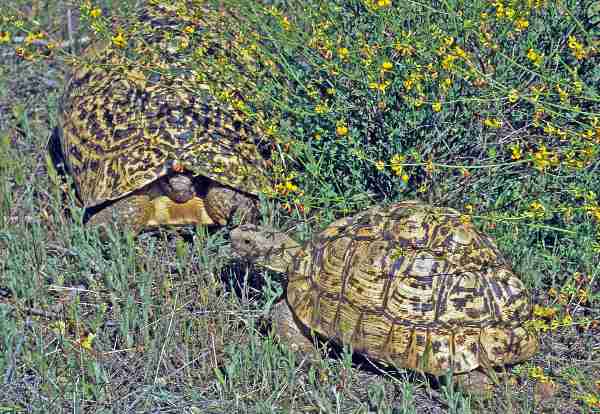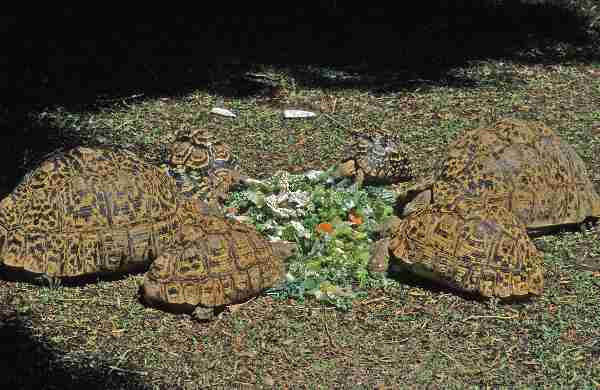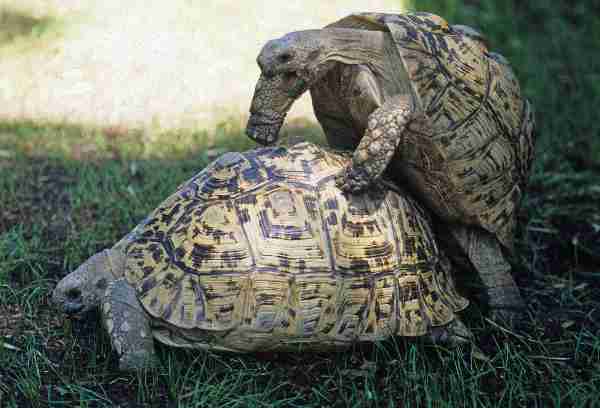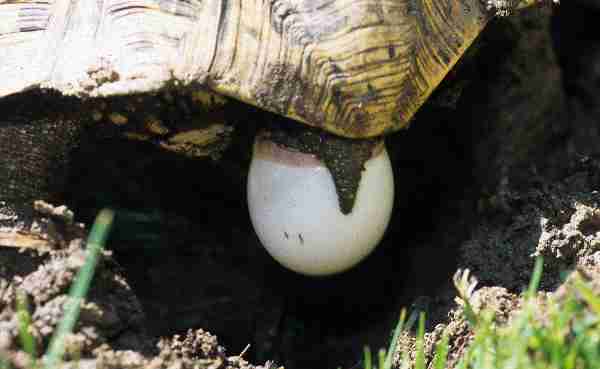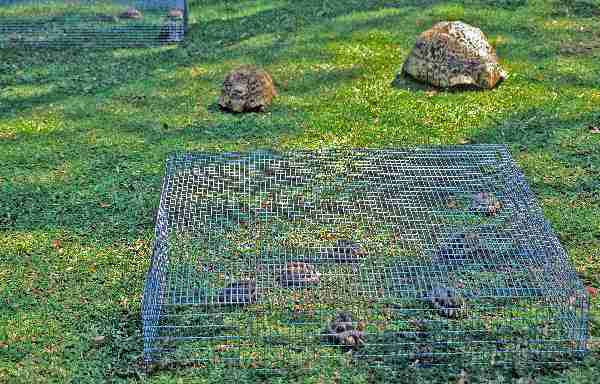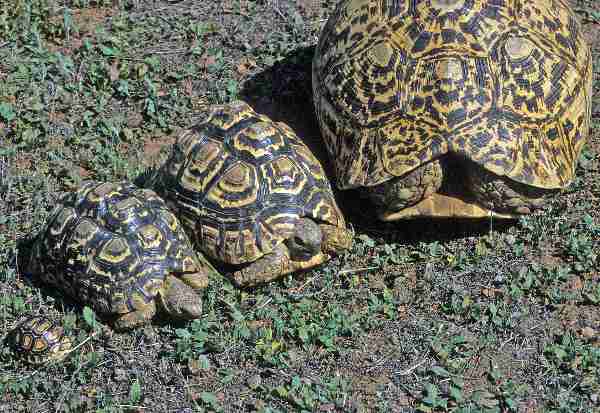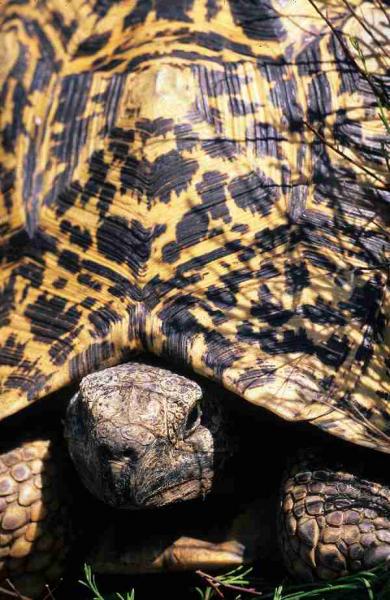E.J. Pirog
Presented to the BCG Symposium at the Open University, Milton Keynes, on 7th March 2009.
Description
The leopard tortoise Stigmochelys (= Geochelone) pardalis is unmistakable due to its distinctive pattern and unique body form. Its shell is relatively highly domed with a height greater than half its length as a general rule. The scutes on the carapace or upper shell may be pyramidal or slightly raised in height on animals from the wild. The colour and pattern give the tortoise its name, being straw yellow with splashes of jet black evenly dispersed over the shell, quite reminiscent of a leopard cat (Fig. 1). Adult tortoises can obtain a size of over 40kg but are more typically in the range of 10 to 15kg when full-grown (Branch, 1988), with a length in the range of 40 to 50cm.
At present only one species of leopard tortoise is recognized (Boycott & Bourquin, 2000). Two subspecies, Geochelone pardalis pardalis and Geochelone pardalis babcocki, have been widely recognized in the past (Loveridge & Williams, 1957) with the most distinguishing difference between the two being the shell pattern of the juveniles. Juvenile G. p. pardalis is recognized by multiple spots on the centre of each individual carapace scute and G. p. babcocki will vary from having no spots, to one spot, to one spot attached to a scute border. A few other characteristics such as size of adults and shell shape have also been mentioned, but are too inconsistent, due to the great range and overlap of the different populations, for these characteristics to be used for any definite identification purposes. So, at least for now, it makes things simpler not to recognize subspecies of the leopard tortoise.
Fig. 1. Male and female leopard tortoises. Photos by E. Pirog.
Distribution
The leopard tortoise range extends south from Angola, ranging throughout the southern African continent and up the east coast, occurring generally east of the Rift Valley up to southern Sudan (Iverson, 1992).
Habitat
This tortoise seems to be quite versatile in its selection of preferred habitat. It has been found from semi-desert to grasslands to scrublands to forest (Euan Edwards, pers. comm.). This has actually added to the argument for the recognition of more than one subspecies, or species, because there has been some speculation that the populations found in their respective habitats fail to do well in the habitat of the others. This could be considered as a reason why some of those taken from the wild fail to adapt to captivity, because it is assumed they all come from the same habitat or general conditions, which is not the case.
Care in captivity
Housing
By far the best housing for these tortoises is of course outdoors. Not only is it the best for the health and well-being of the tortoise, but it is the easiest to maintain if the set-up is right. The minimum area should be no less than 5 metres square for a pair or trio of adults. The area should contain a high quality grass because these tortoises are very active grazers and grasses should make up the majority of their diet. Solid fencing should be used to contain the animals so they cannot see to the other side; it has been found that this cuts down on the tortoises’ attempts to go through the fence. The depth of fence buried into the ground is of no real concern because leopards are not very active burrowers. They are quite content to just plough into a corner when they are in need of rest and choose to bed down. For this reason, provide some low-lying shrubs or bushes for shelter. Also include in the pen a water bowl or pool where clean fresh drinking water is available at all times. This can be sunk so the rim is just slightly above ground level, which makes it easy for the tortoises to drink and also aids in cleaning. Leopard tortoises do have a tendency to drink vast amounts of water if it is available, and it is believed that this is a very important consideration in the animals’ well-being when maintaining these tortoises in captivity. The water containers may be easily cleaned and filled by the blast of a garden hose on a daily basis.
A heated structure should be provided in those areas where temperatures are expected to drop below 15° Celsius. Such a structure may be constructed out of a ¼ inch plywood shell with a 2 inch foam inner lining and a ¼ inch inner shell on all six sides. Provide a removable lid to access the inside for cleaning and monitoring the tortoises and cover the door opening with any available fabric that will minimize circulation with the outside air during cold weather. With this construction you can heat a 10 foot square structure to 25°C with an outside air temperature of 0° C with one 50 watt unit. You can use a ceramic heating element, a bulb, or a heating blanket of any type. The floor can be covered with plastic or linoleum to keep the wooden floor from rotting. The tortoise pen should include a structure such as rocks or logs in order to provide some exercise and to break the line of sight should more than one tortoise be kept in a single enclosure. This aids in the escape of a tortoise which prefers to ignore the unwanted advances or aggressive behaviour of another pen mate, and can reduce unnecessary injury due to such behaviour.
It is sometimes inevitable that the tortoise must be maintained indoors, unless you have a heated greenhouse in cooler climes. A corral may be constructed from a 4 x 8 foot sheet of ¾ inch plywood cut widthwise into 2-foot wide strips. Secure the ends with wood screws so the structure can be assembled and disassembled as needed. The floor can be covered with any thick grade landscaping plastic to keep the floor from being soiled. As bedding you can use landscaping bark or hay. Again, be sure to provide a water dish with clean water at all times. A good container for the water would be a glazed flower pot saucer. The glazing makes it easy to clean and difficult for unwanted material to adhere to the bowl. To provide heat, you can use a clip-on bell-shaped lamp which can be found at most hardware stores. A 75 to 100 watt flood bulb should provide an adequate warm spot. If necessary more than one lamp may be utilized, as UV light may also be needed. The 4 x 4 foot area should be more than ample room for a pair or a trio of tortoises on a temporary basis. Usually during the periods of cooling the tortoises will begin to slow down and will not require much space or feeding. Juveniles may be maintained in a container of no less than 1 x 2 foot. Plastic sweater boxes or even an old fish tank are good for this purpose. If using a fish tank be sure to provide adequate ventilation to avoid excessive heat build-up. When providing heat, always try to arrange the heat source so it is radiating from above, for a more natural provision of thermal regulation. Be careful not to overdo the heat source: although it may not feel like it to you, it may burn the animal if it is too close to the shell.
If conditions are right the little ones can be very active, and by nature they do like to wander, so try to provide as much space as practical. Indoor/outdoor carpeting with no backing is used to provide adequate footing and ease of cleaning for the flooring. Shredded newspaper or fresh hay is provided for security and, in the case of hay, added roughage. A jar lid or any shallow dish has been used successfully with youngsters to provide water. The tortoises will utilize this daily and it should be cleaned, washed and filled every day. Another option for providing water is to soak the tortoise every couple of days, but this is not recommended, mainly because leopards seem to have a preference for drinking great amounts, so providing water at all times allows the tortoise to determine its own drinking schedule.
Captive habitat
As a general rule with leopard tortoises you would try to create what might be considered a comfortably warm climate for most people. Temperatures should range from 20 to 30°C, although they can tolerate temperatures down to 5 and up to 33 degrees. One particularly large female was noted nesting when the outside air temperature dropped to 10°C; she continued digging, laying eggs and completed the nesting process with no adverse effects, although she did take five hours.
Preferred relative humidity is believed to be approximately 40 to 50% although tortoises have shown increased activity on both very dry and also very humid days. Established animals do not seem to have any actual preference, although during days where the humidity climbs above 70 to 80% the incidence of runny noses seems to increase. During periods of cooler temperatures and high humidity it is quite important to keep the tortoise as dry as possible and to pay particular attention to any sign of respiratory problems, as leopards seem to be more sensitive to respiratory ailments at such times. Checking for signs can be accomplished by lightly tapping the tortoise on the nose, causing it to quickly withdraw, expelling the air from its lungs. Do this with the tortoise’s head near your ear. (Be careful that your ear is not mistaken for a tasty morsel of cauliflower.) If a guttural sound is heard deep in the nasal passage or throat, seek veterinary care immediately.
Most if not all tortoises seem to fare better if they are made to feel secure. The leopard tortoise is no exception, so provide hiding places either in the form of a box or more preferably a substrate that the tortoise can plough into. For this you can use hay, shredded paper or even an old towel so the tortoise feels it is hidden.
Feeding
Once a newly acquired tortoise has settled in it will usually begin to explore and go hunting for food, although wild-caught imports are notorious for taking longer than usual to acclimatise to their new surroundings, if at all. For the leopard tortoise, a diet high in fibre and low in protein is the general rule, as it is for most tortoises which are grazers, but this should not be a real concern if a varied diet is provided. Animal protein should not be fed. If the tortoise has access to the great outdoors this should not be a problem because it will spend most of its active time grazing on whatever grass is available. This may be sparingly supplemented with squash, lettuce, carrots, kale, endive or any dark green leafy vegetables (Fig. 2). Feed spinach, broccoli, kale and cabbages sparingly, if at all. If fruit is fed do so sparingly. Food should be lightly coated on a weekly basis with one of the many multiple vitamin/mineral supplements available on the market. Tablets can be ground to a fine powder, which can be very lightly sprinkled on food items. It is a common and expensive mistake to overuse supplements: once a week should be more than adequate. A calcium supplement should be provided on a regular basis, preferably in any form of calcium carbonate. Leopards seem to show an attraction to cuttlebone, which is a chalky structure found in cuttlefish, a type of squid. This can be purchased at any feed or pet shop. Both juvenile and adult tortoises will chew and scrape at the cuttlebone with apparent pleasure. This action actually has a second very important benefit by keeping the beak and nails reduced, eliminating the need for pedicures and beak trims. The cuttlebone can also be ground in a grinder or blender to a very fine powder that is easily sprinkled over the food. This should be done at each feeding. The use of calcium cannot be stressed enough, particularly in the case of juveniles and nesting females. If using a calcium supplement with D3 it is suggested that this should be done with care. There is some speculation that the overuse of these supplements might lead to kidney problems or even failure. If you are limited to keeping the tortoises indoors, provide a diet as close as possible to the one mentioned, bearing in mind that these are primarily grazing animals. There has been some success in growing grazing material in flat plastic trays placed near a window and allowing smaller tortoises to use this daily.
Fairly recently some well researched and well balanced manufactured diets for tortoises have reached the retail market. These have greatly reduced the nutritional guesswork that has plagued the tortoise-keeping world. Many of them have been used by zoos and large collections for well over 30 years, with amazing results that have produced very healthy and well-formed tortoises. Hatchlings in particular seem to develop very well. When feeding any of these diets, always follow the manufacturer’s recommendations, or feed them as a supplement to a dark green leafy diet. Tortoises fed these diets seem to acquire an extreme taste for them.
Fig. 2. Leopard tortoises feeding.
Breeding
With leopard tortoises, once they are acclimatised, warm, secure and well fed, the males tend to become frisky. Around February to March in the warmer latitudes of the Northern Hemisphere male leopards are on the prowl (Fig. 3). They appear to very actively hunt for females. If and when one is found the male will become quite persistent in his pursuit. He will begin by walking or even running up to a noticed female and begin courtship by ramming and bumping her and bobbing his head. He does this to make her notice him and stand still if she is actively feeding. She will usually respond in typical female fashion and just either ignore him or continue grazing. But the male, in typical male fashion, continues until he is accommodated by the female to a point where she finally tolerates his advances. The male will climb on the back of the female and try to wrap his long tail under the aft of her shell until he succeeds in copulation (Fig. 4). In the process it appears as if he is working very hard. While mounted on the female he will open his mouth very wide and emit a rasping wheeze with each motion. The female usually just continues grazing through the entire process until the male either loses interest or tires. This entire process can occur through spring and summer on a daily basis. Nearing September this behaviour eventually subsides and the male will try to mate only occasionally through December. The female will begin to nest in September at the earliest and can continue until March at roughly 30-day intervals.
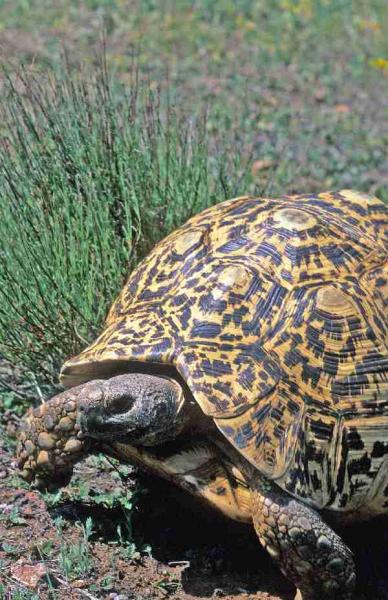
Fig. 3. Male leopard tortoise on the prowl.
Fig. 4. The mating process.
Nesting
When the female is ready to nest she will indicate this by continuously pacing as if she is a tortoise with a mission, which she is. This will occur a few days before she actually nests. Selection of a suitable nesting site seems to be an individual preference, and roughly correlates to areas exposed to the sun for the greatest part of the day, but tortoises have also nested in concealed areas with no direct exposure to the sun. When the tortoise finds a particular area to nest she will begin by scraping the surface in circular motions alternately with her hind legs. Her long toenails will begin to loosen the dirt, which is then picked up with the long nails and deposited to either side. If it becomes too hard she will moisten the dirt in the hole with fluids stored in her bladder (Fig. 5). She does not use all the fluid at once, but will do this a few times in the course of digging the nest. It is amazing that the amount of liquid stored can turn the dirt to a very fluid consistency. The hole itself is not much bigger than the eggs that will pass into it, and opens up below the surface into a flask-shaped cavity roughly 4 to 5 times the diameter of an egg. The depth of the cavity is determined by the farthest length of the outstretched hind leg. If an obstruction is encountered such as a root or rock the tortoise will usually dig around it. Very rarely will a leopard start a nest and abandon it, as some other tortoises will. When the nest is completed the female can deposit from 5 to 21 eggs depending on the size of the tortoise and of the eggs (Fig. 6). The average clutch size for a 13kg tortoise is 10 eggs with the tortoise nesting usually four to five times a given season. As each egg exits the cloaca of the tortoise it is slowly lowered into the cavity by the viscous fluid that surrounds it. It is then carefully repositioned in the nesting cavity to make room for the next. When the tortoise has finished depositing the eggs she reverses the process used for digging the hole to cover it up. She will then tamp down the dirt with her plastron and proceed to rough up the area over the nest and around it with the hind feet. When the whole process is complete it is very difficult to see where the actual nest is without having seen it being constructed. In this situation the eggs are then carefully dug up to be placed in an incubator. It is important to be very careful removing the eggs because they are slippery and are usually being removed through a small hole. The problem is compounded by the fact that there are usually eggs under the one being removed, so a dropped egg can also crack the one beneath it.
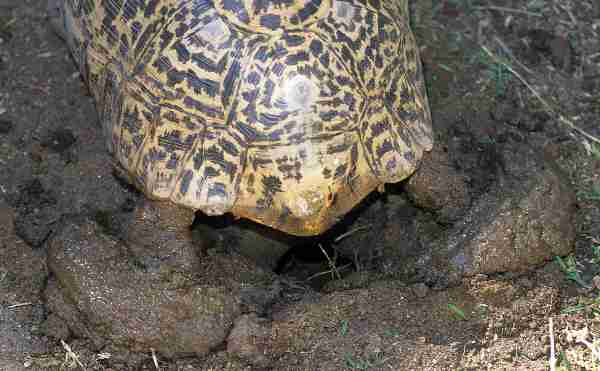
Fig. 5. Female leopard excavating her nest.
Fig. 6. Egg deposition.
Eggs and incubation
Egg size seems to be determined by the size of clutch and not that of the tortoise. Large clutches usually result in smaller eggs and vice versa. The average egg size for a 13kg tortoise is 46 x 41mm with an average weight of 49 grams. The eggs are measured, marked in pencil with large numbers and recorded. They are then placed on vermiculite in a plastic box with holes for ventilation, and moistened once with water in a 1 to 1 ratio by weight. Water is not added again for the duration of the incubation. The box is placed in an incubator at 30° Celsius. The temperature is intentionally allowed to vary between 28 and 30 degrees in an attempt to produce both sexes, considering that the sex of the tortoise is very likely to be the result of a particular temperature at a particular stage of development of the embryo, as it is with many turtles and tortoises. Depending on the temperature at which the eggs are incubated, they take from 88 to 163 days to hatch, with an average duration of 129 days. There are reports of leopard tortoise eggs hatching after 14 months (Bowker, 1926) but this is far from typical.
When hatching, the baby tortoise will punch a small hole in the egg with what is referred to as an ‘egg tooth’ (Fig. 7). This is a sharp protrusion on the tip of its upper beak which eventually wears away as the tortoise matures. In theory, the hatchling will sit in the egg until all the yolk is absorbed. Leopards usually hatch with a good portion of the yolk sac still unabsorbed; in this case the baby is placed upright in a teacup with moistened paper towel in the bottom. This keeps the yolk sac moist and the tortoise restrained, so the yolk sac is not damaged until the yolk is fully absorbed, which takes a few days, at which time the tortoise is moved to a plastic shoe box lined with a thin layer of moist paper towel. The lower shell or plastron is not fully flattened yet because the tortoise hatches somewhat folded with the shell still not fully hardened. By placing the tortoise on a hard, flat, moist surface it allows the plastron to properly flatten out before hardening. Meanwhile the tortoise is still in the incubator. When removed from the incubator and placed in suitable quarters, the hatchling tortoise is ready to be introduced to food and water. The average size for a hatchling in this case is 47mm straight line carapace length with an average weight of 27 grams.
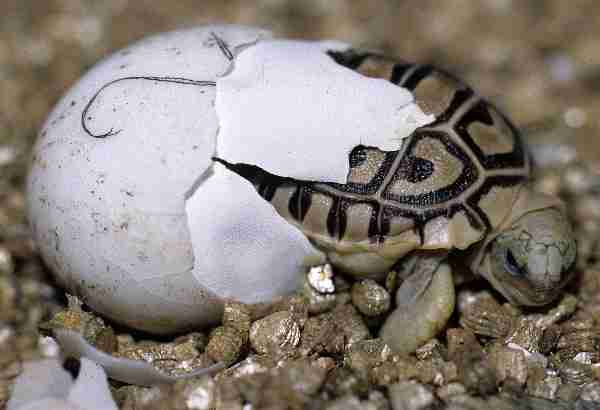
Fig. 7. Hatchling emerging from the egg, clearly showing its ‘egg tooth’.
Development of the young
In feeding the young it is very important to provide a balanced high fibre diet, making sure you provide adequate hydration and calcium supplementation. Basically it is suggested you treat the hatchlings as you would the adults, except that their food should be chopped into small pieces and mixed up so they will be sure to get a balanced diet at each feeding. Hatchlings can take up to a month to begin feeding depending on the temperature and activity level. These two things will determine how quickly the tortoise burns up its natural reserves and actually needs to begin feeding. Finally, there is no substitute for sunshine (Fig. 8). This, provided with the above, will ensure a well-formed and healthy tortoise. If sunshine cannot be provided a good UV light is essential. Normal growth can be expected at a rate of one inch per year following the above regime (Fig. 9).
Fig. 8. Outdoor accommodation for juveniles.
Fig. 9. A range of sizes: hatchling, 5 years, 10 years, adult leopard tortoise.
Conclusion
This is an account of the results obtained from two male and three female leopard tortoises that were maintained over a period of 23 years. The breeding notes were obtained over a five year period from 1994 to 1998. During that time 357 eggs were deposited, mainly by two females, with 234 eggs hatching. This gave a hatch rate of 66%. Unfortunately in this day and age everything requires a disclaimer and this is no exception. These are the observations of one group of tortoises kept in the southern USA. The suggestions and recommendations that appear here are just those, suggestions. Do not be afraid to experiment within reason. It is always recommended to learn as much as you can and apply whatever makes your little tortoise well adjusted and happy (Fig. 10).
Fig. 10. Portrait of a leopard tortoise.
References
Branch, Bill (1988). A Field Guide To The Snakes And Other Reptiles Of South Africa. USA: Ralph Curtis Books, p. 26.
Bowker, F. (1926). Tortoise Eggs and Nests. South Afr. J. Nat. Hist. 6: 37.
Boycott, R.C. & Bourquin, O. (2000). The South African Tortoise Book, 2nd edition: O. Bourquin, South Africa, pp. 139-144.
Edwards, Euan (8 May, 2001). Personal e-mail communication.
Iverson, J. (1992). A Revised Checklist with Distribution Maps of the Turtles of the World. J. Iverson, USA, p. 252.
Loveridge, A. & Williams, E.E. (1957). Revision of the African Tortoises and Turtles of the Suborder Cryptodira. Bull. Mus. Comp. Zool. 115(6): 163-557.
Testudo Volume 7 Number 2 2010.
Top

